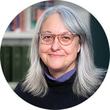- OT
- Professional support
- AOP
- Linking people with sight loss to sources of help
Linking people with sight loss to sources of help
AOP policy adviser, Kathy Jones, on how her family has experienced the value of charitable eye care support first hand

28 July 2019
My father, now 96, was diagnosed with age-related macular degeneration (AMD) well over 10 years ago, around the time that National Institute for Health and Care Excellence (NICE) was in the process of approving the use of Lucentis in wet AMD. After that, visits to the Prince Charles Eye Unit at Windsor’s King Edward VII Hospital became a regular part of his life. Sometimes they injected, sometimes they didn’t, and all the time Dad’s eyesight continued its gradual deterioration.
After he’d retired from his job as a headteacher, Dad had put more time into his hobbies. He learned to make stained glass and became adept at Chinese brush painting. But his deteriorating sight made it harder and harder for him to carry on with these hobbies – a matter of great regret to him. We bought him a bigger television and a photocopier so that Mum could make the Guardian cryptic crossword big enough for him to see, but in due course even that wasn’t any help.
Both Dad and Mum were always part of clubs and societies. Dad was a founder member of Bracknell Rugby Club, and at various times a member of Rotary, Roundtable and the Lions Club; they were always putting something back into the community.
Dad now finds it strange to be the recipient of charitable support, but we couldn’t be more grateful
He now finds it strange to be the recipient of charitable support, but we couldn’t be more grateful – for the expertise and advice, as much as for the amazing equipment that they have provided. There are two such sources that we are particularly grateful to in our family: the Macular Society, which has an active local group where Dad lives, and the Blind Veterans Association, which provides help for veterans whether their sight loss is associated with their service or not.
I recently attended the Seeing Beyond the Eyes training provided by Daniel Williams’ consultancy business Visualise, which underlines the importance of linking people with sight loss to sources of help and advice as soon as possible to reduce the loneliness and depression that can accompany a diagnosis. I believe that the optical practice has a big role to play in this and a new editable patient leaflet the AOP will launch in August makes this very easy to do.
Image credit: Getty
Advertisement


Comments (0)
You must be logged in to join the discussion. Log in